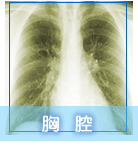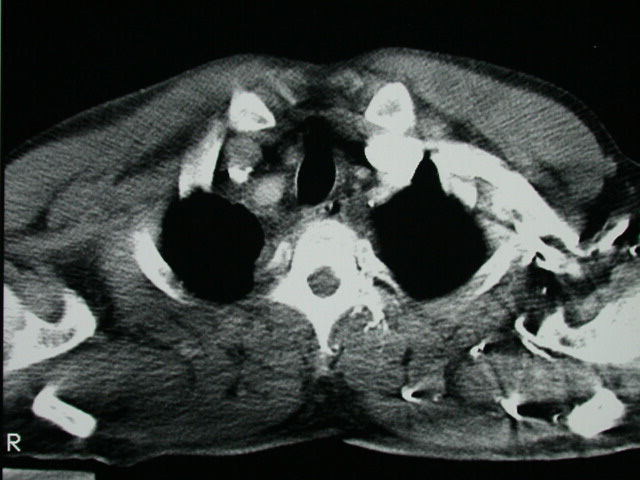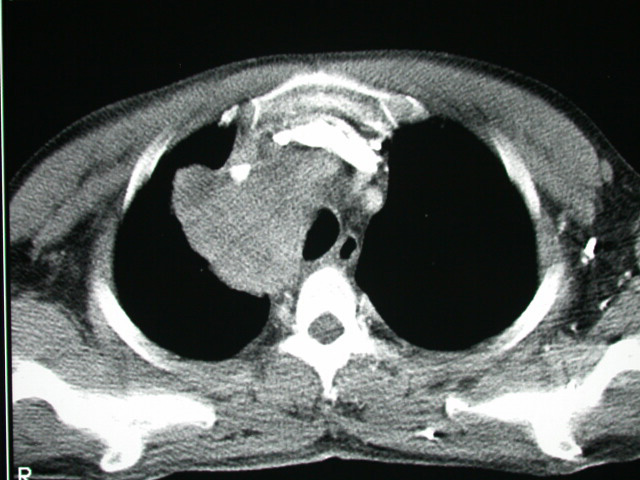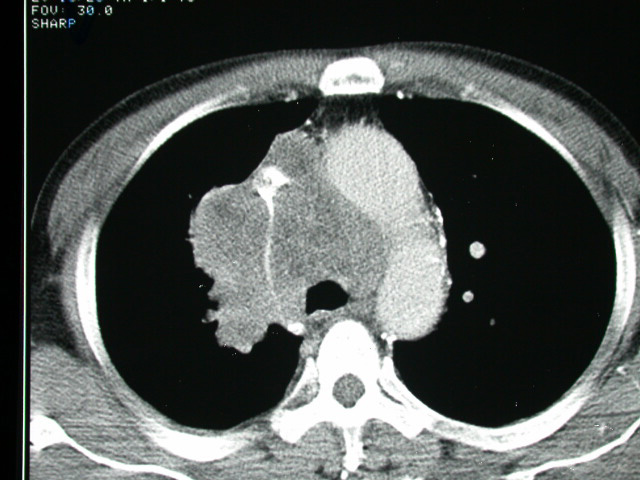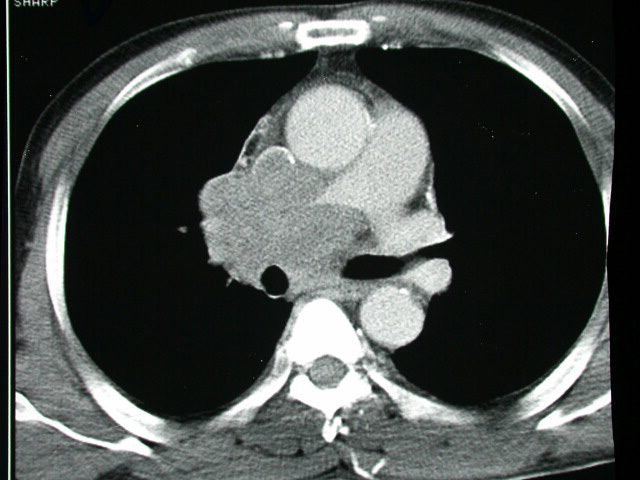History :
This 48 y/o gentleman, a heavy smoker consuming 1PPD of cigarettes
for 30years, had been well until two month ago when dry cough was
noted. Facial swelling were noted since 1 month ago.
Image finding :
-A huge mass at least 9 cm in diameter on axil plane located at middle
mediastinum predominate at right side.
-There is tumor encasement of the right main pulmonary artery and
azygos vein.
-There is anterior displacement of SVC and direct tumor growth into
the SVC.
-Enlarged right hilar lymph node is also noted.
-There is also encasement of the right upper lobe bronchus.
-Mass effect of the tumors upon the intrathoracic trachea which is
compressed and slightly deviated to left side.
Diagnosis :
Small cell lung cancer, right upper lobe, limited stage, with superior
vena cava syndrome.
Discussion :
Small cell undifferentiated carcinoma (15%) :
-Strongly associated with cigarette smoking Rapid growth + high
metastatic potential (early metastases in 60-80% at time of diagnosis);
-should be regarded as systemic disease regardless of stage;
-virtually never resectable
-smooth-appearing mucosal surface endoscopically
-ectopic hormone production: Cushing syndrome, inappropriate secretion
of ADH
-Most common primary lung cancer causing superior vena caval obstruction
(due to extrinsic compression / endoluminal thrombosis / invasion)!
Location:
-90% central within lobar / mainstem bronchus (primary tumor rarely
visualized)
-typically large hilar / perihilar mass often associated with mediastinal
widening (from adenopathy)
-extensive necrosis + hemorrhage
-small lung lesion (rare)
Staging evaluation: CT of abdomen + head, bone scintigraphy, bilateral
bone marrow biopsies
SUPERIOR VENA CAVA SYNDROME
=obstruction of SVC with development of collateral pathways
Etiology:
(a)Malignant lesion (80-90%)
-1.Bronchogenic carcinoma (>50%)
-2.Lymphoma
(b)Benign lesion
-1.Granulomatous mediastinitis (usually histoplasmosis, sarcoidosis,
TB)
-2.Substernal goiter
-3.Ascending aortic aneurysm
-4.Pacer wires / central venous catheters (23%)
-5.Constrictive pericarditis
Collateral routes:
-1.Esophageal venous plexus = "downhill varices" (predominantly
upper 2/3)
-2.Azygos + hemiazygos veins
-3.Accessory hemiazygos + superior intercostal veins = "aortic
nipple" (visualization in normal population in 5%)
-4.Lateral thoracic veins + umbilical vein
-5.Vertebral veins
*head and neck edema (70%)
*cutaneous enlarged venous collaterals
*headache, dizziness, syncope
*with benign etiology: slower onset + progression, both sexes, 25-40
years of age
*with malignancy: rapid progression within weeks, mostly males,
40-60 years of age
*proptosis, tearing
*dyspnea, cyanosis, chest pain
*hematemesis (11%)
-superior mediastinal widening (64%)
-encasement / compression / occlusion of SVC
-dilated cervical + superficial thoracic veins (80%)
SVC thrombus
NUC:
-increased tracer uptake in quadrate lobe + posterior aspect of
medial segment of left lobe (umbilical pathway toward liver when
injected in upper extremity) |

